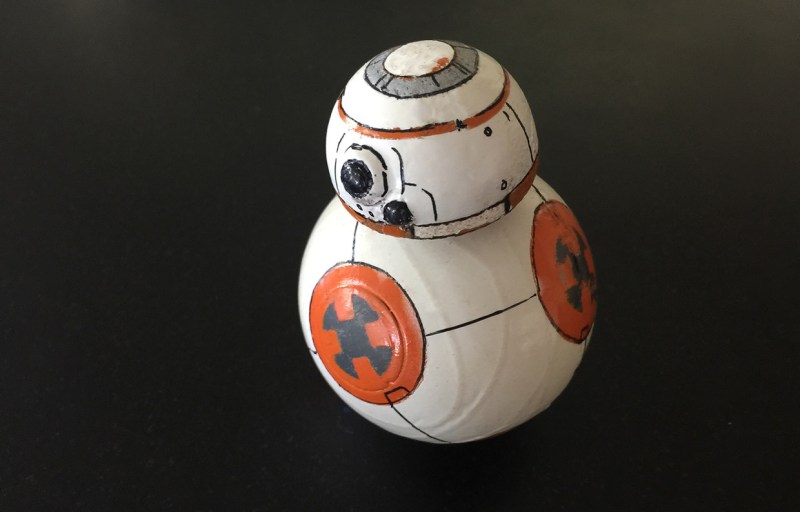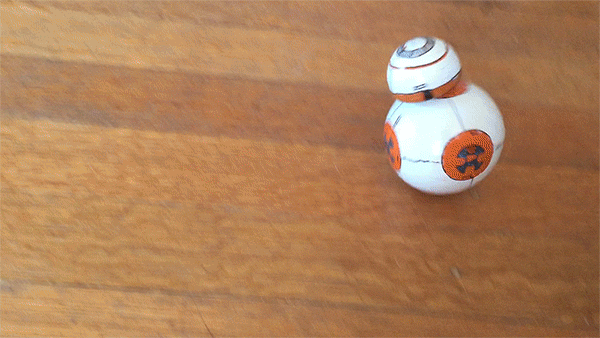Hot on the heels of discovery that the BB-8 Droid from the new Star Wars movie is real, [Christian Poulsen] has made the very own miniature version of it!
It’s a brilliantly simple hack actually. Remember the Sphero? It’s a remote controlled ball you can drive around with your phone — great fun, but surprisingly not many people have hacked it…
The ball has an internal structure that allows it to roll around with ease. Which also means it has a fixed up direction — at least inside of the ball. All [Christian] had to do was crack it open and throw a magnet on the top of the inner-assembly. He then machined the droid’s head out of foam with another magnet (or metal, we’re not too sure) and boom-bada-bing it stays in place as the ball rolls.
Stick around after the break to see some GIFs of it adorably rolling around — and into things.
So simple, but awesome.
[Thanks for the tip Vik!]

















First, [James], it’s “Bada-Boom, Bada-Bing”. You’ll never get things done saying it your way.
Second, [Christian] has solved the mechanism. The characteristic forward-lean of the head is present in his model.
big bada boom?
Muuuultiiiii passss
Strange, I’d thought this solution would make the head lean backwards when the robot is rolling. It’s almost as if the film is running backwards.
In order to keep balance, and counteract acceleration, it needs to lean forward.
It’s the same as when your up in a bus or subway, you lean forward when the mahcine accelerate.
It’s even more obvious with the segway, but it’s reversed. You lean forward, and to keep balance, the segway has to accelerate.
Not in this case. If you look at how the Sphero is built, it has a smal. robot inside. To move forward, the robot inside the sphere moves forward (and so does the centre of balance), and the ball rolls forward. The foam head, which is much lighter, is held on the other side of the sphere by the magnet. Thus, when the robot is going forward, the head should tilt backwards. This is opposite to a typical balancing robot where the moving mass is in the head. Therefore, I find it peculiar that the head is leaning forwards in the animated gifs. Either there must be an articulated arm inside moving the head, or the video is played backwards… or I might me wrong of course.
yeah more likely answer is we are misunderstanding how the sphero works as that second video would work like that is it was ran backwards.
I tried a Sphero once, and I’m pretty sure that is how it works. Have a look at my reversed video below. I think [Christian Poulsen] is having a little fun with us.
Looking at the hand movements, it is not unlikely that the female is trying to make it look that she is giving it a push when video is run in reverse. (And why only publish an animated gif, and no Youtube video?)
hey everyone! I’m glad you’re all enjoying my little robot friend here! first off, I assure you no video trickery is involved, here’s the actual video https://youtu.be/yu6x9sJCGfo
as some of you have correctly pointed out, what’s happening is the sphero is now more top-heavy that it normally is. so when you get the head to lean in a direction, the gyro will try to compensate for the lean and move in the same direction. Basically, the body is always trying to catch up with and get underneath the head. the balancing a broomstick idea.
feel free to check out my website for a few more process pics — http://www.cp3d.us/#/bb-8-sphero-droid/
as well as my full how-to write up — http://makezine.com/projects/make-this-mini-star-wars-bb-8-ball-droid-with-a-hacked-sphero/
Way cool that there was no trickery involved. I didn’t realize that the head would alter the center of gravity that much.
Great work!
“Leaning backwards” would make the task harder. Think of balancing a stick on the palm of your hand. If it leaned backwards, you would have to move backwards to counter the imbalance.
Keeping in mind that the movement is caused by the robot inside the ball, not the very light foam head, this is how I would expect it to move:
http://i.imgur.com/1zg3VaW.gif
Seems my attachment of the reversed gif didn’t work. For those that want to see it, the URL is i.imgur.com slash 1zg3VaW.gif
And also noticing now that my first comment was under the name [Esplod], while the remaining as [lodden]. Sorry about that. It’s the first time I use the comment system on hackaday.
I’d imagine that since there is friction, the Sphero pushes the head forwards as it spins. Just look at the way the surface moves. When the ball moves forward the top surface also spins forward.
wow, I can see armies of hackers building armies of these. Can’t wait to see the designs and uses that are created.
When the movie comes out the shelves will be groaning with them, but what hackers do with the prebuilt ones should be interesting.
Hmm….4 of these and some custom software = the cars from I,Robot???
http://www.gizmag.com/spherical-drive-system-omnidirectional-electric-motorcycle/24095/
I don’t know if anything cane of it, but these guys were trying it. I wanted to do one myself, but realised I’d have to custom manufacture a treaded rubber ball…
Just when you thought Straw warped could not get any more silly or irritating… Hello jar jar droid!
I think what some people may be missing is where the center of gravity is. If the center of gravity is below the geometric center of the sphere, then the “head” would tilt backward as it accelerates forward. This is the way a lot of ball-based mechanisms work. But the magnet holding the head on (and I assume, other internal mass) is well above the geometric center, so as others have pointed out, it has to tilt forward to accelerate forward.
This is a bit of a control system challenge, because it means that to initiate forward acceleration, the mass has to first rotate forward, which produces a torque that rolls the ball backward. But as anybody who’s tacked the inverted pendulum problem (or learned to ride a unicycle) knows, it can be done.
I tried something like that with magnets too.
https://youtu.be/liCiiVKDm-0
I was trying to work out how the real-life version worked. It’s got independant head movement as well, so I’m thinking internal gyroscope and motor which turns the ball underneath, whilst staying on top?
The independant head movement could be achieved by having a level articulation inside the ball from the base robot to the magnet, or inside the head, moving the lightweight head around the magnet